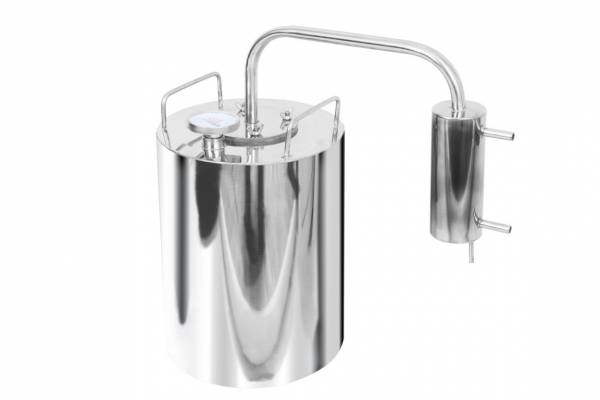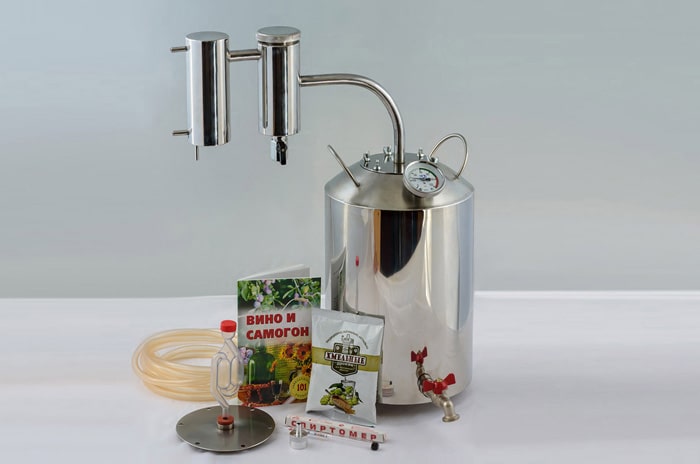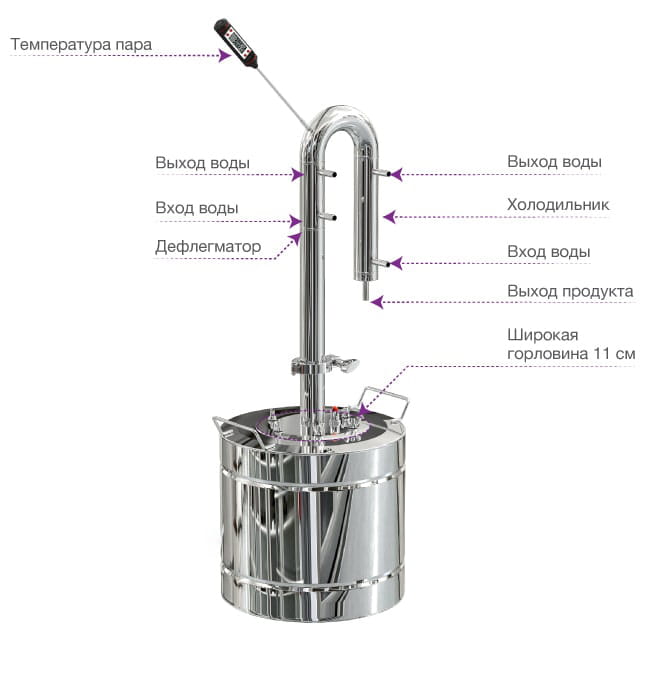- Information
- About Us
- Service and Warranty
- Delivery and payment
- News
- Contacts
- АКЦИИ
How to choose a moonshine still?
24.05.2019Surely, every adult has at least once visited the obsession with making moonshine or another home-made alcoholic drink. This is especially true for those who have just arrived from a rural holiday, where they have often treated themselves to a pervach or fragrant liqueur. It's a matter of small! It is enough to purchase a household moonshine to have a tool for the implementation of the idea.
But which distiller to choose? There are many offers on the market, the choice is not easy. Not only is the price of many devices very high, they are frightened by the complexity of the design, long instructions, and the duration of the technological process. Don't give up right away. We just need to take a step forward and the situation will become clearer. When you figure everything out, you will immediately become the master of the situation and will be able to proudly treat your friends to your own made alcohol.
So, let's take a closer look at how to choose the right moonshine so that it meets the following requirements:
- Was comfortable to use.
- Meets all safety requirements.
- Produced high quality products.

Decide on the price
Initially, you should understand how much money you are willing to spend on buying a distiller. After all, a model of a well-made, fully equipped moonshine still costs at least about 4,000 hryvnias. Cheaper devices are either not fully equipped or are made of materials that are not suitable for such equipment.
An important note: choosing a distiller by cost is not quite the right decision. A low price may indicate a low quality equipment. It should be understood that the purchase will quickly pay off, since the alcohol obtained with the help of the unit will cost significantly less than buying drinks in a supermarket. Well, in general, moonshine does not only provide its own needs with inexpensive alcoholic beverages. This is more of an occupation for the soul, a kind of hobby, and it is much more pleasant to work with high-quality and functional equipment.
Where will the device be installed?
Before buying a specific distiller model, consider where it will be used. After all, it is necessary for the device to fit there in terms of its size, to have free access to it. It also requires a source of heat and plumbing for its operation. The ideal place in the house is the kitchen, where there is an electric or gas stove, as well as a cold water tap.

If you plan to use a moonshine in a country house where there is no running water, then the best choice is a distiller, the design of which has a non-flowing cooler filled with cold water manually.
As practice shows, the most comfortable sources of heat for the distillation cube are induction cookers, which provide the required temperature with high accuracy and uniformity of heating. Although, if you set up the operation of an electric or gas stove, the result is also very good. There are distillers on sale that have built-in heating elements, which makes them independent of an external heat source. The only drawback of such equipment is that mash often burns on thermal elements.
How to choose the right moonshine in size? After all, there should be enough space not only for a distillation tank installed on the stove, but also for a steam outlet, dry steamers, a refrigerator with a coil, a beer column, and a container for distillate. For example, in the kitchen of a standard city apartment, it is unlikely that it will be possible to place a moonshine still larger than 20 liters, a container or a distiller equipped with a distillation column.
Raw materials for mash
To prepare the wort, which serves as a raw material for mash, sugar or starch-containing products are used. In the process of fermentation, yeast bacteria produce ethyl alcohol from carbohydrates. The materials for the wort are sugar, jam, fruits, cereals, potatoes, etc. This circumstance also affects the choice of distiller, copper or stainless steel.
The mash recipe directly affects the taste of the resulting drink, and also affects the internal surfaces of the distiller in different ways. The most trouble-free is sugar mash, which leaves practically no traces on the walls of the equipment. For her, the best option is moonshine stills made of food grade stainless steel. Fruit or grain mash is characterized by a large amount of impurities that leave plaque on the surface and burn marks even after pre-filtration. If such raw materials will be used frequently, it is recommended to buy a distiller made of copper. It costs more, but the high cost is justified by the fact that copper is easier to clean and has a beneficial effect on the quality of the original product.
The dimensions of the moonshine still and its components, the materials used
It seems that the information received is quite enough to confidently show in the store which distiller to choose. But there are many nuances that at first glance are not so important. At the same time, it is recommended to take them into account.

When planning to use a moonshine still for their own needs, let alone work with it in a city apartment, many people make the mistake of choosing a model with the smallest volume of a distillation cube. The problem with this solution is the following.
According to technology, the distiller should be filled no more than 3/4 of the volume of the distillation cube. Otherwise, drops of mash will inevitably get into the distillate and spoil its taste. Next, there is a simple mathematical calculation - the ratio of well-prepared mash / alcohol yield / moonshine yield is 1:10:5. That is, from 10 liters of mash you can get 2 liters of moonshine (strength about 40 °), or by double distillation 1 liter of alcohol (about 90 °).
In practice, the results are very close to the calculated values. Using a moonshine still (volume 15 cm3) with dry steamers or a mash column, from 10 liters of mash we get 1.5 liters of strong alcohol (strength about 60-65 °). Now once again calculate which distiller to choose depending on the volume.
As for the main material of the distiller. As mentioned above, household appliances are made either from food (medical) stainless steel or copper. Dry steam tanks (reflux condensers), steam vents, a coil, a refrigerator, a beer column, etc. should be made of similar material.
The thickness of the metal of the distillation cube should be in the range of 1.8-2.0 mm. Thinner metal causes overheating and burning of the mash. Thicker walls do not carry a useful function, they only lead to an increase in the mass of the entire apparatus.
If you are not sure how to choose the right moonshine, Prolitech managers will be happy to advise you. Just call us at the contact phone number +38 (098) 192-18-20 or order a callback on the website.
